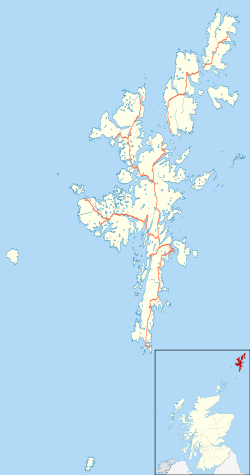
The former Royal Air Force Station Kenley, more commonly known as RAF Kenley was an airfield station of the Royal Flying Corps in the First World War and the RAF in the Second World War. It played a significant role during the Battle of Britain as one of the three RAF stations specifically tasked with the defence of London. It is located near Kenley on the edge of Greater London. The site remains in use with the Ministry of Defence, as Kenley Airfield.

Sullom Voe is an inlet of the North Sea between the parishes of Delting and Northmavine in Shetland, Scotland. It is a location of the Sullom Voe oil terminal and Shetland Gas Plant. The word Voe is from the Old Norse vagr and denotes a small bay or narrow creek. The head of the voe makes up the eastern side of Mavis Grind.

The Saunders Roe A.27 London was a British military biplane flying boat built by the Saunders Roe company. Only 31 were built, entering service with the Royal Air Force (RAF) in 1936. Although due for replacement by the outbreak of World War II, they saw some active service pending the introduction of the ultimately unsuccessful Lerwick.
John Alexander Cruickshank VC is a Scottish former banker, former Royal Air Force officer, and a Second World War recipient of the Victoria Cross (VC), the highest award for gallantry in the face of the enemy that can be awarded to British and Commonwealth forces. Cruickshank was awarded the VC for sinking a German U-boat and then, despite serious injuries, safely landing his aircraft. He is the last living recipient to have been awarded the VC during the Second World War.

Royal Air Force Catterick or RAF Catterick is a former Royal Air Force airfield located near Catterick, North Yorkshire in England. It is located alongside the A6055 road on the outskirts of Catterick Village.
Royal Air Force Drem or RAF Drem is a former Royal Air Force station, just north of the village of Drem in East Lothian, Scotland. The motto of the station was Exiit Hinc Lumen which means "Light has departed from this place".

Scatsta Airport, was a commercial airport on the island of Mainland, Shetland in Scotland located 17 nautical miles north of Lerwick and 5 mi (8 km) southwest of Sullom Voe Terminal.
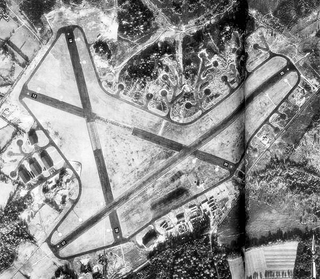
Royal Air Force Holmsley South or more simply RAF Holmsley South is a former Royal Air Force station in Hampshire, England. The airfield is located approximately 5 miles (8.0 km) northeast of Christchurch, Dorset; about 90 miles (140 km) southwest of London
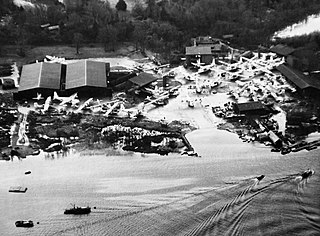
Royal Air Force Castle Archdale or more simply RAF Castle Archdale, also known for a while as RAF Lough Erne is a former Royal Air Force station used for flying boats by the RAF and the Royal Canadian Air Force in County Fermanagh, Northern Ireland.
Royal Air Force Fairlop or more simply RAF Fairlop is a former Royal Air Force satellite station situated near Ilford in Essex. Fairlop is now a district in the London Borough of Redbridge, England.
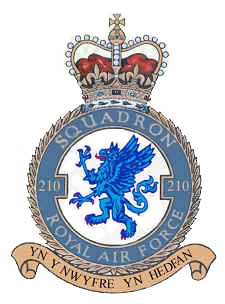
No. 210 Squadron was a Royal Air Force unit established in World War I. Disbanded and reformed a number of times in the ensuing years, it operated as a fighter squadron during World War I and as a maritime patrol squadron during the Spanish Civil War, World War II and the Cold War before it was last deactivated in 1971.
No. 204 Squadron was a Royal Air Force unit first formed in March 1915 as No.4 Squadron Royal Naval Air Service.
Royal Air Force Eastchurch or more simply RAF Eastchurch is a former Royal Air Force station near Eastchurch village, on the Isle of Sheppey, Kent, England. The history of aviation at Eastchurch stretches back to the first decade of the 20th century when it was used as an airfield by members of the Royal Aero Club. The area saw the first flight by a British pilot in Britain.
Royal Air Force Bolt Head or more simply RAF Bolt Head is a former Royal Air Force satellite airfield 1 mile (1.6 km) south west of Salcombe on the south Devon coast, England from 1941 to 1945. During the Second World War it was used as a satellite for RAF Exeter. There were two runways, of 3,680 ft at 45° and 4,200 ft at 120°
Royal Air Force Castletown or more simply RAF Castletown is a former Royal Air Force station that operated during the Second World War. Built near to Castletown in Caithness, Scotland the station opened in 1940 and closed in 1945. Initially built to provide a base for fighter cover for the Royal Navy base at Scapa Flow, it later became an air-sea rescue base as well, before closing just after the end of the war in Europe.

Royal Air Force Newchurch or RAF Newchurch was a temporary Second World War airfield at Newchurch, Kent. It was a base for a Hawker Tempest wing that gave fighter cover over occupied France in the period up to and beyond D-Day and later defended south-east England against attack from V-1 flying bombs.
Royal Air Force Skitten or more simply RAF Skitten is a former Royal Air Force satellite station directly east of the village of Killimster, located 5.1 miles (8.2 km) north east of Watten, Caithness, Scotland, and 4.7 miles (7.6 km) northwest of Wick, Caithness, Scotland. On 19 November 1942, Operation Freshman departed from RAF Skitten.
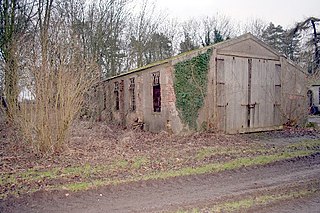
Royal Air Force Wellingore or more simply RAF Wellingore is a former Royal Air Force fighter relief landing ground located 1.9 miles (3.1 km) south of Navenby, Lincolnshire and 10 miles (16 km) south of Lincoln, Lincolnshire, England.
Royal Air Force Limavady or more simply RAF Limavady is a former Royal Air Force station, also known as Aghanloo airfield, near the city of Derry, Northern Ireland.
Sullom is a village on the Shetland peninsula of Northmavine, between Haggrister and Bardister. It lies on the northwest side of Sullom Voe, to which it gives its name.
